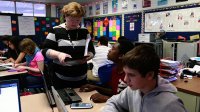How a Single iPad Can Benefit a Whole Class
Students working in pairs explain math problems to each other using an iPad—and then pass it to the next pair.
Your content has been saved!
Go to My Saved Content.My class has one iPad. Just one. But I have found ways to put this single iPad to use in such a way that everyone in my class benefits.
Having mastered one app -- the Show-Me app -- I have been able to create podcasts for my students, allowing them to access my help on their assignments while they are at home or when I am unavailable for face-to-face teaching or tutoring.
After I became comfortable with using this app, I began to brainstorm ways I could use it within my classroom. One technique is to have my students create their own podcasts. The process looks like this:
- First, I take pictures of selected problems that align to the standards I am teaching. Then, I load the pictures into the Show-Me app on my iPad.
- After direct instruction, I pair students based on their levels of confidence in solving these types of problems. The goal is to match up a confident student with a student who is feeling less secure about the lesson concepts.
- I choose a problem for the more confident student to teach to the struggling student, I hand the iPad to that student, and I walk away to let the student independently make a podcast without me hovering nearby. During the recording of the podcast, the first student, solves a problem, explaining the process to the less-confident student and recording all of the work, step by step.
- The pair of students lets me know they have finished, and I choose a similar problem for the less confident student to teach to her partner. This student then teaches her partner, explaining each step.
- After one pair finishes, I move to another pair of students in the room and repeat the process, using the same or similar problems. While the iPad is making the rounds from pair to pair, the rest of the class is working on either pencil and paper assignments or online activities related to the day’s lesson.
With help from my technology coordinator, I learned how to project the podcasts that my students made onto my whiteboard. When students volunteer to show their podcasts publicly, everyone in the class receives additional opportunities to learn problem solving which may be different from the “teacher’s way.”
Although the idea of students teaching each other is not new, utilizing this app as the means to do so provides additional benefits beyond the immediate process.
- Students talk through each step of their problem-solving procedure while they are recording their podcasts, increasing their understanding of the mathematics through their detailed explanations.
- Students learn how to analyze and critique each other’s work and engage in classroom discussions about different ways to solve problems.
- Using the iPad increases my students’ engagement and participation in class, as they all want their chance to use the technology. My students are more motivated to show what they know, and they learn to provide assistance through difficult steps as their partners are working through their problems.
I have found that I can use student-produced podcasts as formative assessments. Being able to save their work allows me to watch their podcasts later. I can view the podcasts throughout the week and ascertain the standards with which my students are struggling. I make notes while I am reviewing their podcasts so that I know in which areas they show strength and can determine areas to be addressed during individual teacher-student conferences. If I notice that many students are having similar difficulties, I use that information to help me plan for future instruction.
Having only one iPad has not limited my ability to use technology effectively with my students. It is a great tool for analyzing what my students know and can do, and it definitely increases their participation, motivation, and success in the mathematics classroom.
